| Article ID | Journal | Published Year | Pages | File Type |
|---|---|---|---|---|
| 5351239 | Applied Surface Science | 2014 | 9 Pages |
Abstract
WO3 plate-like array film was grown on the FTO electrodes by a simple hydrothermal method. In order to change the microstructures of the WO3 films, the as-grown films were further post-heat treated in air and in H2, respectively. The photoresponse characteristics of the as-prepared WO3 films are investigated in the gas phase, and to explain the slow decay of the photocurrent of WO3, the electron trapping effect is proposed. We found that both of the phase structures and oxygen vacancies had great influences on the photoresponse characteristics of WO3 films. For the three WO3 films, the photocurrent decreased significantly with the distortion of the octahedra which were the building blocks of the various crystal structures and with the decreasing of oxygen vacancy concentration. The untreated-WO3 shows 2.5 times higher photocurrent intensity than hydrogen-treated WO3 and the hydrogen-treated WO3 shows 17 times higher photocurrent intensity than air-treated WO3. The experimental results revealed the influence of phase structure on the photoelectric performance of WO3 was far greater than that of oxygen vacancy. We also found that the hydrogen-treated WO3 exhibited excellent infrared photoresponse property, which was 20 times higher than that of the pristine WO3. This was attributed to the existing large number of oxygen vacancies yielding extended energy states which often formed a continuum extending to and overlapping with the conduction band (CB) edge.
Related Topics
Physical Sciences and Engineering
Chemistry
Physical and Theoretical Chemistry
Authors
Chaoqun Yang, Qiang Zhu, Shunping Zhang, Zhijun Zou, Kuan Tian, Changsheng Xie,
